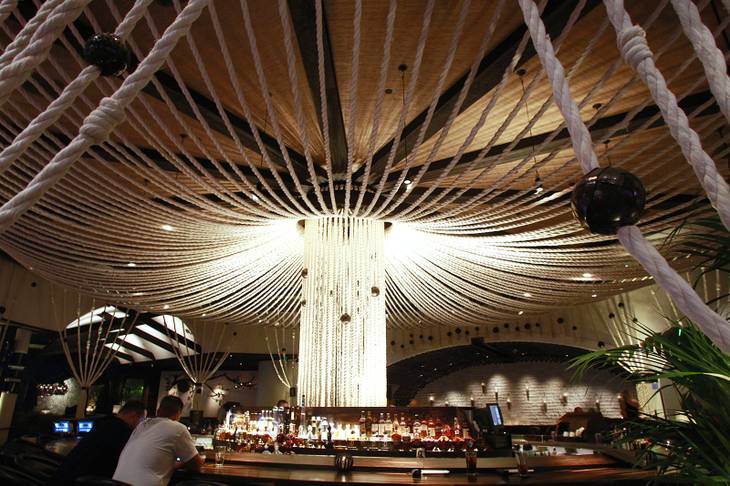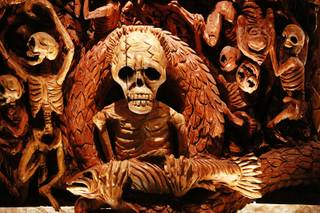It takes more than good food for a restaurant to succeed on the Las Vegas Strip.
Atmosphere can be equally important. Many local restaurateurs import the country’s top designers to create restaurant settings that are just right.
One such designer is Peter Bowden, director of design and development for Dodd Mitchell, a global design firm. He is the mastermind behind Javier’s, a new high-end Mexican restaurant in CityCenter’s Aria. The 9,000-square-foot restaurant opened this fall.
Bowden said one of his biggest challenges was making the restaurant stand out from the nearby casino while still providing an intimate setting for diners. The restaurant's centerpiece is a 3,000-pound, chainsaw-carved wood mural that portrays Mayan myths and Mexico.
What design challenges did you face working with such a large footprint?
Creating an intimate feeling in such a large area is a challenge.
Visually, we try to get something to grab your eye, whether it's a unique texture, an interesting character or something you haven't seen before. You have to keep people engaged.
We try to create vignettes. There are arches so you can see into the space. You have the menu board and the wooden tree, all meant to draw you in. One element you see from across the casino is the ropes hanging like a canopy over the bar.
The thick white ropes frame the bar like a curtain. How did that concept come about?
That’s more of a theatrical concept: How can we visually pull someone from 200 feet away into the space?
The ropes angle up, kind of like eyelashes, to direct you. We pulled out the bar from what it used to be, so people have to look in.
It's like a beacon for the Aria. There are a lot of little bars here, but nothing like the Cosmopolitan’s Chandelier Bar. We wanted that one anchor spot.
The hostess looks like she's under a spotlight. Why?
The idea is to have a glowing person on the other side of the entrance accept you. It was originally going to be made out of wood, like a confessional.
There are these little hints of religion throughout the space. The arches are a little like a Spanish chapel. It is grounded in the Mexican culture, which very much revolves around Catholicism.
Initially, we had a lot of crosses in the design, which we'd never done before. But in Las Vegas, you get such a broad mix of people, we pulled that out.
Some have compared the bar to a roulette wheel. Was that your inspiration?
I've heard the roulette wheel, too. But our inspiration was a small piece of pottery. We built a bigger version of it for the bar.
There are a couple of interesting features. The way the ribs come up underneath the bar gives women a place to hang their purses. We also have charging stations hidden in the bar. That's one of the problems you have these days: you want people to stay at the bar but their phone batteries start to die and they have to leave to go back to their rooms to recharge them. We thought: What if we gave them chargers?
At each end of the restaurant, you have big elements: a large private dining room and an oversized mural. Why?
We try to give people something visually interesting and different every 10 feet or so. It keeps the action moving. It's all about keeping energy within the space.
We took this long linear space and created interesting moments along the way. Because the restaurant is shaped like a kidney bean, you have all these opportunities to look through the space from one end to the other.
What is the story behind the mural?
It was inspired by 3-D dioramas and European relief art.
We went back to the Mayan story. The history of Mexico and Central America all goes back to the Mayan creation myth, and that's the basis for most of the panels, blended with modern Mexican history, Catholicism and Christianity.
I asked J. Chester Armstrong, the artist from Oregon, to pack as much Mayan creation myth, modern history, imagery and interwoven story lines into each square inch as possible. Each panel is a different experience.
How long did it take him to create?
He did it in six weeks.
What is the story behind the wood chainsaw mural?
There are five panels. You start with the tree of death. The guy on the left side is sucked into the cave. As he gets pulled out of the cave, he gets murdered. His head gets cut off and hung on the tree.
At that point, the dead skeleton spits on the woman, who becomes pregnant with twins — the hero twins.
It's this long, elaborate, nonsensical story.
At the end of it, the King of Death is killed, and he rises to the Earth's surface, which you can see through all five panels, and he becomes the Corn God. Then all the corn grows from him.
Then you have the Conquistadors coming over from Spain and the battles.
It's really amazing that it was done with a chainsaw.
It was originally something my metal artist, Scott Brown, was going to create. Then Dodd Mitchell came in and said, "I love the concept for the space, but we're going to do it all out of chainsaw art."
He loves taking normal things and bringing it to a level people have to pay attention to.
Wood is the medium that people think of as eagles and grizzly bears taken from logs and standing on the side of the road. This creates something that no one has ever seen. He wanted to do something so different, people would just scratch their heads.

